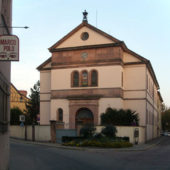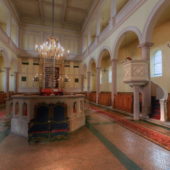Neo-Romanesque synagogue in a fine old Alsatian town
Located in the French Alsatian town of Colmar, this synagogue was constructed in neo-Romanesque style between 1839 and 1842. It is the product of a particularly busy period of synagogue construction that took place throughout the Alsace region from 1789 to the onset of World War I in 1914. Reforms inspired by the French Revolution allowed Jewish life across France to flourish once again after centuries of oppression. And during this time, nearly 200 synagogues were built in the Alsace region alone.
Jews have lived in the Alsace since Roman times and records indicate they were citizens in good standing in Colmar through the medieval period until the beginning of the First Crusade in 1096 when a long period of mounting repression began. By 1215, Jews in Colmar and elsewhere were required to wear a yellow badge by Papal decree. Nevertheless, Colmar retained a significant Jewish population that worshipped in a synagogue that ultimately was destroyed by fire in 1279.
When the Black Death swept through Europe in 1348 killing millions, the locals in the Alsace Region blamed Jews for causing the disease by poisoning water supplies. Several Jews were burned at the stake in Strasbourg and the rest were evicted from their towns for a time.
Jews were readmitted to Alsatian towns, including Colmar, by King Wenceslas in the late 14th century but by 1512 they were banished again to nearby villages. A conflicting series of decrees alternately banishing and restoring the Jews were passed until finally they were expelled to the countryside. Jews did not set foot in Colmar again until 1691.
With its simple, neo-Romanesque lines suggesting solidity and strength, the Colmar Synagogue features prominently in Colmar, a town of approximately 67,000 residents. Windows provide abundant illumination to a large, interior main room with a high ceiling and rather plain, unornamented walls, while columns and arches run the length of the room on both sides. The capitals of the columns, however, lack the distinctive foliate or Corinthian style that often characterizes Romanesque structures.
The Jews of Alsace were principally Ashkenazi in origin, observing the traditions of Eastern and Central European Jews. However, Alsatian Jews did develop some of their own traditions including a liturgy called the Minhag Elzos, which was probably used in the Colmar Synagogue. Many also spoke a Judeo-Alsatian dialect similar to Yiddish.
Predictably, the Jewish population of Colmar was severely reduced when the Nazis overran France in 1940 and occupied this region for the next four years. During that time, they wrecked the synagogue. In 1959, locals restored it. Unusually, it features a tiny belfry at the top of its front pediment, though the ringing of bells is traditionally not part of Jewish worship. The synagogue today can be visited by appointment.


